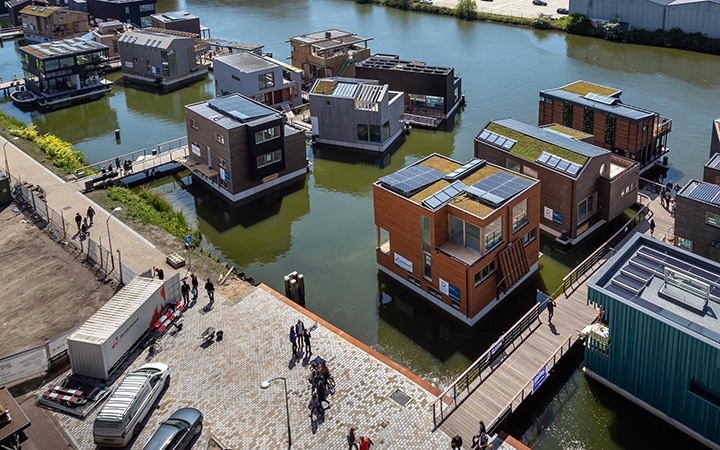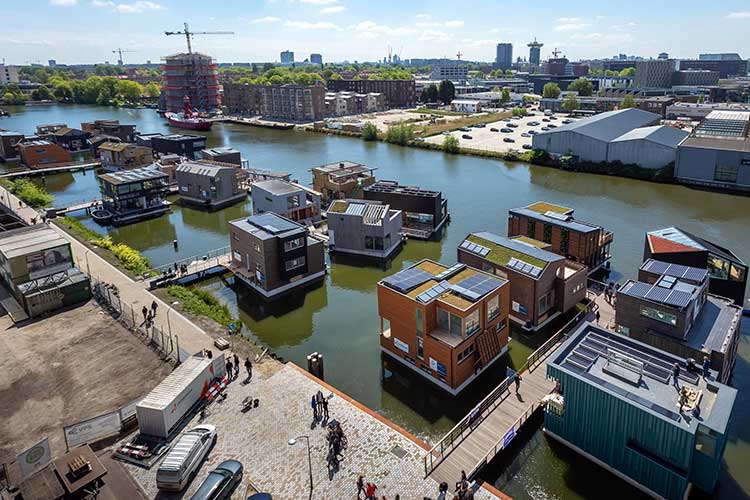In July 2019, a study by nonprofit Climate Central and real estate technology firm Zillow showed that many of the highest rates for new home construction in the United States are in the same places that are also most at-risk for flooding due to rising sea levels amid climate change.
While this obviously raises questions about the human psyche, it also poses an interesting engineering challenge: If people insist on living near water, why not live on top of it?
Earlier this year, the United Nations Human Settlements Programme began theoretically exploring the potential for “sustainable floating cities.”
While this line of thinking may be seen as unusual, humanity will likely be in need of new housing solutions for the future, especially as climate change continues to escalate.
Houseboat history
To be sure, floating housing is nothing new. Houseboats have existed for hundreds of years. But, more recently, developers have begun to incorporate sustainable building practices in larger, neighborhood-scale projects that could serve as models for better ways to live near Earth’s coastal areas.
Many of these advances have come from the Netherlands, where about a third of the country sits below sea level. Earlier this year in northern Amsterdam, residents began moving into a floating development known as “Schoonschip.” The neighborhood, which consists of 46 homes spread across 30 unique buildings, owes its existence largely to its founder, television producer Marjan de Blok, who was inspired by the idea after she interviewed Pauline Westendorp, a local energy advocate, in 2008.
At the time, Westendorp was the manager of a sustainable houseboat venue called geWoonboot. “That’s the way of living I wanted for myself,” de Blok said. “So self-sufficient and independent. It just felt great to be on a boat, too.”
De Blok combined forces with several friends and colleagues who shared her vision for a more sustainable life on the water, but it would take more than a decade of negotiating with the government and other stakeholders to eventually bring the project to life.
Houseboat: real estate or not?
Koen Olthuis, founder of Dutch architectural firm Waterstudio.NL, which specializes in floating structures and helped bring Schoonschip to life, said that kind of complexity is typical when dealing with floating real estate.
Part of the problem: Is a houseboat real estate?
“If [the government] calls it a boat, they can’t get any taxes, but they can constrain the lease to 10 or 15 years, so they can get rid of them after some time,” Olthuis said. “If they call it real estate, they can make taxes from it, but then it’s very difficult to break up or change these situations.”
Also, according to many countries’ laws, real estate can’t be mobile, meaning you couldn’t reconfigure your floating neighborhood if you wanted to classify it as real estate. “The technology is there, but for municipalities it’s very difficult to choose what to do,” Olthuis said.
Sorting these types of legal issues out has been a major challenge for Olthuis and others working to bring floating architecture to the mainstream, but there are also technical challenges. Among them: How do you balance a floating, three-family dwelling unit when only one of the families has moved in?
“On land, it doesn’t matter if you change your furniture or bring a piano in,” Olthuis said. “In water, you can imagine if your neighbor starts to bring in much more weight, the house starts to be unbalanced.”

Where can houses float?
For Schoonschip, the houses use ballast tanks that can be filled with water to offset any weight differences—a lessoned learned through previous failures. Olthuis said these advancements are emblematic of the maturity he’s seen as floating housing has advanced in the last two decades.
In terms of where to build a floating neighborhood, Olthuis recommends old harbors that are no longer in use. These locations usually come with built-in protection from surf such as breakwaters or jetties; they also tend to have existing infrastructure that makes it easier to secure the houses in place. The cost of real estate on land can be astronomical in the center of many modern cities, which can make building in an urban harbor an economically attractive option.
“In the center of Amsterdam, the water is much more affordable,” Olthuis said. “You pay less for the water than you would for a square meter of land.”
As governments figure out how to deal with the intricacies of floating housing, Olthuis said he expects to see these neighborhoods becoming more dynamic and modular—able to change shape to accommodate seasonal residents or new structures like floating greenhouses or swimming pools as needed.
Olthuis said he’s also working to make better use of structure that exist below the waterline and even the water itself. Because water is extremely resistant to temperature change, it can be used to passively cool the homes in the summer and heat them in the winter. There are also currents flowing through water that can be harnessed for electrical power.
“The role of the architect is not only drawing a nice picture but understanding the ecosystem and the physics of the water; understanding the rules and regulations; understanding the money. It’s quite a diverse spectrum we’re working with,” Olthuis said.
For de Blok, moving into her floating home felt like a dream come true. She’s hoping all 46 residences will be filled by January 2020. Because the houses are all connected—both by their unique sustainable nature and by their electrical grid—de Blok said the sense of community is strong.
“Everyone has his own job, his own life, his own family,” de Blok said. “But when the sun is shining you meet on the jetty, and when you have a problem you call your neighbor, and when you need to borrow a hammer, it’s right there. We really share everything.”











